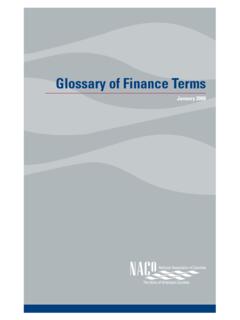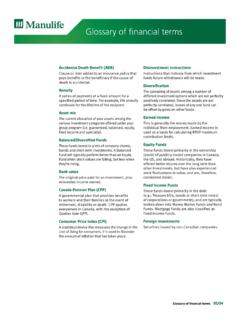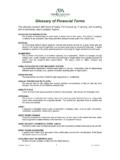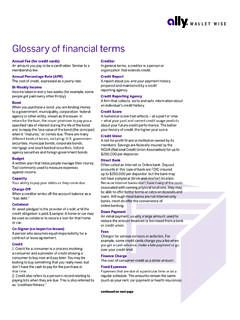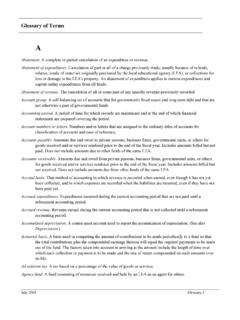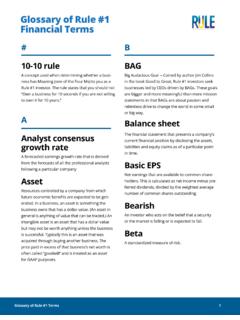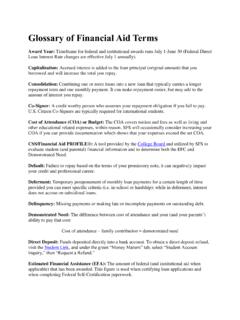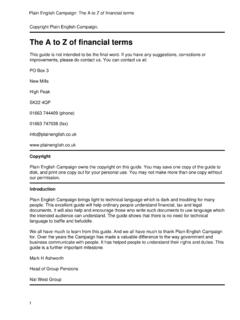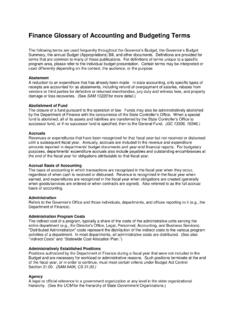Transcription of Glossary of Terms - Council for Economic Education
1 FINANCING YOUR FUTURE, NATIONAL Council ON Economic Education , NEW YORK, of TermsGlossary of TermsAnnual percentage rate (APR) the interest ratecharged, expressed as a percent per year, for the useof creditAssets possessions that have Economic value(some of which may provide an Economic and/orfinancial return)ATM automated teller machine; an ATM allowsbank customers to deposit and withdraw moneywithout the direct assistance of a bank a company chartered by state or federalgovernment to offer numerous financial services,such as checking and savings accounts, loans andsafe-deposit boxes; the Federal Deposit InsuranceCorporation (FDIC) insures accounts in federallychartered banks and most state-chartered a certificate of indebtedness issued by agovernment or a company, promising to repay bor-rowed funds to the lender at a fixed rate of interestand at predetermined intervalsBorrower an individual, business or governmentthat has received and used something belonging tosomebody else, with the intention of returning orrepaying it - often with interest in the case of bor-rowed moneyBudget a plan to manage income, spending andsavingCapital gains a profit realized from the sale ofproperty, stocks or other investmentsCash money in the form of paper currency orcoinsCashier's check a form of check bought for a spe-cific amount and paid to a person or firm named onthe check.
2 People pay a fee for a cashier's check. Acashier's check cannot bounce because full pay-ment is needed prior to a cashier's check being of deposit (CD) a certificate issued bya bank to a person depositing money in an accountfor a specified period of time. A penalty is chargedfor early withdrawal from most CD a written order to a financial institutiondirecting the financial institution to pay a statedamount of money, as instructed, from the cus-tomer's accountChecking account a financial account into whichpeople deposit money and from which they with-draw money by writing checks or using debit orATM cardsCompound interest a situation in which interestis earned on previously earned interest in such away that earnings accumulate more rapidly overtimeCredit borrowing to buy something with thepromise to make payment at a later timeCredit card a small, specially coded plastic cardissued by a bank, business, etc.
3 , authorizing thecardholder to purchase goods and services on cred-it. Credit cards allow users to borrow funds (thatmust be repaid) that the user does not report a written record collected by a cred-it agency that tracks a borrower's credit payments,whether or not these payments are made on a time-ly basis, and how long the borrower has had variouscredit accountsGlossary of TermsVVideo 1: Get a financial Lifeideo 1: Get a financial Life146 FINANCING YOUR FUTURE, NATIONAL Council ON Economic Education , NEW YORK, of TermsCredit union not-for-profit cooperatives ofmembers with some type of common bond ( ,employer) that provide a wide array of financial ser-vices, often at a lower cost than commercial banksDebit card a small, specially coded plastic card is-sued by a bank; allows the cardholder to transferfunds electronically and immediately from his orher checking account, as if the cardholder werewriting a check to pay for a purchase.
4 A debit cardis different from a credit card in that debit cardusers are limited to accessing only the available bal-ances in their deposit accounts. Credit cards allowusers to borrow funds that must be to invest in a variety of financial assets,such as stocks, bonds, money market accounts, etc.,in order to reduce the overall risk of financial in-vestmentDividend a payment of apportion of a company'snet profits which is periodically made to stockhold-ersExpenses payments for goods and servicesFICO score a mathematical model that assesses aperson's reliability in repaying borrowed fundsFinance charges the interest paid on unpaid cred-it balancesFinancial institutions intermediaries that helpchannel funds from savers to borrowersFinancial literacy basic financial knowledge, in-cluding an understanding of banks and the bank-ing system, financial markets, credit and creditcards, and tax laws, as well as the ability to applythis knowledge in making decisions on how tospend, earn.
5 Or save money today to build wealthfor tomorrowFixed expenses expenses that are the same everymonthGrace period the amount of time one has to pay aline of credit before there is a finance chargeHuman capital the knowledge, skills, abilitiesand talents that people acquire through experience,training and Education that help workers producegoods and services and help determine their in-come-producing capacityIncome earnings that result from providing re-sources in the market placeInflation risk the chance that the rate of inflationwill exceed the rate of return on an investment;also, the risk that future earnings will have reducedpurchasing power because of an increase in averagepricesInstallment plan a closed-end loan for a specificproduct such as furniture or appliancesInterest the price associated with using someoneelse's money.
6 Banks pay savers interest to encouragethem to make deposits. Banks charge interest toborrowers, who pay this interest as a cost of usingsomeone else's money. In general, banks earn prof-its when the interest payments made on loans arelarger than the interest used to attract savers tomake one who lends; may be an individual, abusiness or a governmentLiabilities things that are owed; financial obliga-tions that must be paid. Debt is a common house-hold the ease with which a financial asset canbe turned into cashGlossary of Terms (continued)FINANCING YOUR FUTURE, NATIONAL Council ON Economic Education , NEW YORK, of TermsLiquidity risk the chance that an investor willfind it difficult to turn an investment into cash (bytrying to sell a house, for example, in a real estatemarket that is slow)Long-term goal a goal that a person or organiza-tion plans to achieve more than five years in the fu-tureMedium-term goal a goal that a person or orga-nization plans to achieve in one to five yearsMinimum payment the smallest amount a per-son is required to pay in a given month on an open-ended credit accountMoney market account an interest-bearing ac-count that offers limited check-writing may be added at any time.
7 Some moneymarket accounts limit the withdrawals depositorsmay make without paying a penalty. Money marketaccounts are low-risk investments that serve as across between saving and checking accounts. Mon-ey market accounts offered within the banking sys-tem are known as money market deposit market accounts offered by mutual fundsare known as money market mutual order a form of payment that a personcan buy for a specific amount and sign over to theperson or firm named on the money order. Peoplemust pay a fee to obtain a money order. A moneyorder cannot bounce because full payment is need-ed before the money order is fund a pool of funds used by a financialservices company to purchase a variety of stocks,bonds or money market instruments. A mutualfund provides diversification and is professionallymanaged by investment income the amount of income left after taxeshave been paidNet worth a person's assets, or what a personowns, minus a person's liabilities, or what a personowesOpen-ended credit a form of credit that allows aperson to borrow funds to make purchases forwhich there is no predetermined repayment periodOpportunity cost the highest-valued alternativethat is given up when a choice is madePeriodic expenses expenses that occur periodical-ly, not regularlyProductive resources factors used to produce agood or service (natural resources or land, humanresources, human capital and capital goods)Problem-solving model also known as thePACED model.
8 The five steps of decision-making:identify the problem, list the alternatives, list thecriteria upon which the decision will be based, eval-uate the alternatives using the criteria, make a deci-sionRate of return earnings from a financial invest-ment, stated as a percentage of the amount invest-ed; usually calculated on an annual basisReturn earnings from an investment, usually ex-pressed as an annual percentage rateRevolving credit an open-ended account with alimit to how much can be borrowed but no timelimit for repaymentRisk the chance of experiencing a financial lossRule of 72 offers a simple way to determine howlong it will take for a principal value to double insize. Divide the annual expected interest rate into72 to know the approximate number of years it willtake for the principal to of Terms (continued)148 FINANCING YOUR FUTURE, NATIONAL Council ON Economic Education , NEW YORK, of TermsSaving income not spent on current consump-tion or taxesSavings account an interest-bearing deposit ac-count at a banking establishment that is not typi-cally used for transactions and has no maturity dateScarcity the condition that arises whenever limit-ed resources are insufficient to provide for peoples'basically unlimited wantsShort-term goal a goal that a person or organiza-tion plans to achieve in less than one yearSmart card a plastic card, usually about the size ofa credit card, which has been embedded with a mi-crochip that manages and processes of the chip, the card can handle multipleapplications such as personal identification, bank-ing, and use in pay phones.
9 The cards make it easyto carry data. They provide high data security andoffer great convenience to using income for current consumptionStocks shares of ownership in a corporationTaxes required payments to governmentTrade-off that which is given up to get somethingTraveler's check a form of check that can be usedto obtain cash; the buyer of the traveler's check paysa specific dollar amount to acquire these checks,which are issued in standardized packets by a travel-er's check issuer. The checks are written to a personor firm and signed by the person writing the these come with protection against loss ortheft. Traveler's check issuers usually charge a feewhen they sell these expenses expenses that may change fromweek to week or from month to monthWealth The stock of assets or resources that haveeconomic value - that is, that can produce incomein the future.
10 Note that, broadly speaking, manyabilities - academic, athletic, creative, social, etc. -can be harnessed to produce future income and,hence, are also forms of wealth. Students with theseabilities are potentially wealthy even if they cannotafford to buy the latest electronic device , to translate this potential into actual in-come-producing wealth, and then to manage thatwealth, requires financial of Terms (continued)
